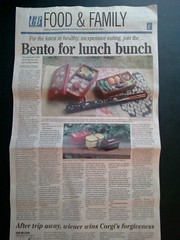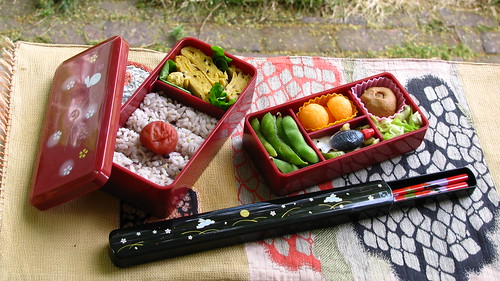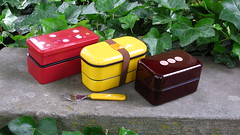
The content below was published in the Walla Walla Union-Bulletin on June 30, 2009:

By MICHELLE MORGAN
for the Walla Walla Union-Bulletin

In this bento box are several good things to eat: tamagoyaki (sweet omelet), sticky rice with Grain Booster and an umeboshi plum in the bottom tier. In the top tier, edamame (soybeans), cantaloupe, celery kinpira, soy sauce, and a miso soup ball with shredded iceberg lettuce.
The first time I came across a bento, it was in the form of a kyaraben (character bento) photo.
I found it one afternoon while randomly surfing the Internet. Some person who clearly possessed more time than sense had turned what appeared to be rice, food coloring, and assorted colorful vegetables into an amazingly detailed forest meadow with a creature in it: there was a tree, a field, a blue sky, and what seemed like a quarter of a million tiny little flowers, all painstakingly cut out of various colorful foodstuffs, beautifully arranged, and entirely edible.
It was not only far too pretty to eat, but it looked as if it had taken about seven hours to assemble! And it didn’t look like it was exactly nutritionally balanced. I mean, who could possibly survive on meals of nothing but rice and raw veggies?
But the thing was just so adorable that I found myself looking at more bentos. And even more bentos. Not only was the food itself delightful, the containers these meals were packed in really grabbed me. They were just so darn cute I couldn’t resist them!
As my fascination grew I discovered that not all bentos are artfully arranged kyaraben depicting edible cartoon or video game characters – those are generally created by moms for their children. A typical bento is simply a homemade luncheon carried to work for same reason anyone takes a homemade lunch to work: to save money and avoid having to eat out.
After falling completely under the allure of adorable homemade lunches with small portion sizes, I ordered my first bento box. As I read more recipes and joined online bento communities I learned all kinds of fun words like soboro (seasoned ground meat, used as a flavoring for rice), kawaii (cute), furikake (savory sprinkles used to flavor rice), onigiri (rice balls, often stuffed with savory fillings), and kinpira (seasoned sauteed root vegetables).
An obsession was born.

Three two-tier women's bento lunch boxes are shown. For recipes, see Page C2.
As much as I’d like to be unique and special in my fascination with kawaii Japanese lunch boxes, a quick Internet search reveals that bento is rapidly becoming a very popular past time in the United States and worldwide. I have online bento friends all over the US as well as in France, Australia, and Switzerland.
There are very active bento communities at JustBento.com, LunchInABox.net, and Flickr.com, where people post pictures of their lunches, swap recipes, and share tips for saving time in the kitchen.
Many bentoers are attracted to the financial and health benefits of packing one’s lunch rather than buying it, and many appreciate the green aspect of reusing containers rather than tossing them into a landfill.
I started bentoing primarily as a diet aid. Bento boxes are quite small and are great for portion control, not to mention that Japanese food is widely considered to be healthy because of its emphasis on fresh fish, rice, and vegetables.
And don’t even get me started on the accoutrements! The boxes, bags, cutlery sets, cups, dividers, and food picks are, without a doubt, guaranteed to make you smile when you clock out and sit down with your lunch. Sure, they’re mostly plastic, but you’ll reuse the items indefinitely instead of loading your local landfill with the styrofoam and cardboard a typical take-out lunch generates.
As science learns more about how essential mental attitude is to health I’ll sit grinning at my kawaii lunch, convinced that the cuteness alone is adding years to my life.
Looking at Flickr.com pictures of bentos packed by actual Japanese eaters reveals that a typical adult’s bento is roughly half rice and half okatu (basically ‘whatever you eat with your rice’). Common okatu items are curry, potato salad, tamagoyaki (sweet omelet), and cooked or pickled vegetables, but the actual rule of thumb follows a ratio of 4:2:1, or 4 parts rice to 2 parts protein to 1 part other ingredients.
Since bentos are often eaten at room temperature rather than refrigerated or microwaved, there’s none of the raw fish sometimes associated with Japanese cuisine. All items are thoroughly cooked and there’s an emphasis on including bacteria-resistant foods, like picked plums or ginger root, citrus juices, vinegar, and that venerated preservative of old, salt.
While many of my own bentos are Japanese-influenced, not all of them are. Sometimes I pack Indian food (rice and curry) or Mexican food (do-it-yourself tacos), or regular leftovers (like Thanksgiving dinner).
In the end a bento box is just a lunch box, and you can pack whatever you like to eat into it. However, there are a variety of inexpensive and low-fat recipes that come out of the bento tradition that are fun to try and good to eat.
If you find you’re charmed by the idea of packing your own bento lunches, you’ll need to know where to obtain the adorable boxes and the extra supplies like picks, sauce bottles, chopsticks, bags, and food cups.
The easiest place to find bento boxes is eBay.com; simply perform a search for “bento boxes.” Be sure to keep an eye on shipping prices, because some sellers are overseas and you end up paying quite a bit for international shipping.
My other favorite bento suppliers are jbox.com, a Tokyo-based company run by an American, and ichibankanusa.com, a US-based company that saves you that pesky international shipping charge.
Most places will list the size of their bento boxes in mililiters; for portion control you need to know that mililiters are roughly equal to calories: a 600ml box will hold about 600 calories. Many women’s bento boxes hold around 480ml, which I’ve found is about right for my caloric needs as a sedentary office worker.
Bento staple items like miso, sticky rice, gyoza (Japanese potstickers), and frozen edamame (soybeans) can be purchased locally at the Asia Oriental Store on Issacs and Andy’s Market in College Place, or online from Amazon.com.
Remember that you can always use a plain, locally-available plastic container as a bento box, too.
I took a look at that first bento picture again, and I can see now that it probably took the creator less than an hour to assemble; that many of the flowers were made of protein sources like cheese or fish cake; that the rice wasn’t tinted with food coloring but by being boiled with natural color sources such as cabbage and beets; and that under the rice was a layer of soboro (seasoned meat).
All of which means that not only have I looked at far too many pictures of people’s lunches, but the first bento I saw was not only gorgeous but also nutritionally balanced and quite possibly even delicious, too.
While I’ll never attempt to match the artistry involved in such a bento, I get a lot of satisfaction out of my own little bento lunches. I’ve even managed to get two of my coworkers into bento, because they were curious about my cute little lunch boxes and the contents thereof. They both own their own bento boxes now, and they each have their own bento style. One makes delicate, complicated boxes with lots of ingredients; the other makes bold, simple boxes. They both get to eat great homemade food whenever they indulge their bento hobby!
I’ve always enjoyed cooking, and I’m especially proud of the fact that I’m saving myself from all the calories, sodium, and fat found in restaurant foods.
If you have any questions about bento, feel free to email me at bento (at) goblinbox (dot) com.
Michelle Morgan of of Walla Walla is a support technician in the Internet industry, where she enjoys a bento lunch nearly every day. On the side she blogs, knits, cooks vegetarian cuisine from around the world, collects cookbooks and reads an inordinate amount of science fiction.
Onigiri is essentially a ball of rice with salt on the outside, sometimes wrapped in nori, sometimes stuffed with something salty.
Onigiri are easiest to form with an onigiri mold, available online, but can also be formed by hand. If hand-forming, remember to keep your hands moist to keep the rice from sticking to you instead of itself!
Ingredients:
prepared sticky rice
salt
canned tuna
mayonnaise
prepared wasabi
nori sheets
Method:
In a bowl, mix tuna with mayonnaise and wasabi.
Put about 1/4 c. of sticky rice into your mold. Place about 2 tsp. of the tuna mixture into the center. Fill the rest of the mold with rice and press.
Wet your hands and salt them. Pat your hands all over the onigiri to salt the outside.
Cut a strip of nori about 4” long and 1” wide. Place it on the onigiri.
To serve:
These rice balls can be eaten immediately, or wrapped in plastic wrap and frozen for use in future bentos. They can be served with furikake or shoyu and extra wasabi.
This is a variation on the stuffed onigiri.
Form a plain, unfilled and unsalted onigiri.
Fry it in a non-stick pan with a tiny bit of vegetable oil. Turn. Brush with shoyu. Turn and brush again. Repeat, brushing and frying both sides twice.
Drain and serve.
This can also be roasted in a dry pan, or over a flame if available.
Ingredients:
white miso paste
bullion
Method:
Cut a square of plastic wrap about 4” per side.
Place 1.5 T of miso paste into the middle of the wrap.
Add about 1/4 teaspoon of bullion.
Wrap the ball and secure it with a twist-tie.
To serve:
Fill a mug with hot water. Add the unwrapped miso soup ball to the mug and stir.
Optional:
Pack any of the following into your bento along with the miso ball. They all taste great in this nutricious, warming instant soup.
* shredded lettuce
* umeboshi
* tiny cubes of tofu
* dried wakame seaweed
* mixed frozen vegetables
* finely chopped green onion
* thinly sliced mushrooms
* shredded carrot
This is an easy, low-calorie vegetable side. It’s a very simple dish that tastes much better than it sounds!
Ingredients:
celery
olive oil
salt and pepper to taste
Method:
Chop one stalk of celery on the diagonal.
Heat a little bit of olive oil in a pan, and fry the celery for about three minutes.
Drain. Toss with a little salt and pepper.
Garnish with sesame seeds, if desired.
To pack a bento, fill half of the box with rice. Then fill half of the remaining space with your main protein dish, and add your side dishes.
To separate your dishes, you can use disposable food cups (available online), silicone muffin cups, or even paper cupcake cups. If your food isn’t hot when you pack it, try lettuce leaves or strips of carrot or cucumber as edible dividers.
Be sure to fill the gaps between dishes, so that your food won’t move around during transport. Gap-fillers can be vegetables like broccoli or cherry tomatoes, wrapped cheeses like Babybel or Laughing Cow, dried fruits and nuts, or even individually-wrapped candies or mini candy bars.
If you have room, you can insert mini pudding or jello cups, pickles, orange wedges, lunch meat roll-ups with cheese or asparagus in the centers, or small whole fruits like strawberries or grapes. Shelled, hard boiled eggs are great bento items too.
Garnish and decorate your bento at the last. Lots of color from fresh fruits and vegetables add both nutrition and visual interest. Add food picks, decorative cut-outs of cheese or nori, and tuck in your sauce bottles.
Make sure the food is cool to reduce condensation before closing the box.
Since the portion sizes are so small, many bentoers make up batches of main and side dishes and freeze them in bento-sized portions. That way you can wake up in the morning, pull some leftovers out of the freezer, garnish them with fresh fruits and veggies, and still manage to be on time for work.